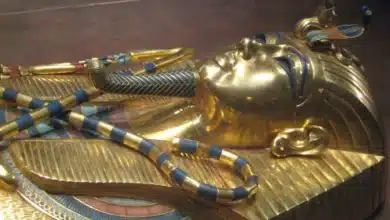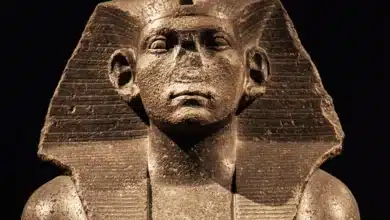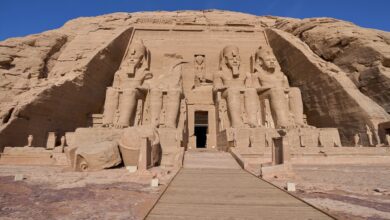The history of the ancient world often portrays Egypt as the sole titan of early civilisation, with its magnificence overshadowing other lesser-known countries. The remains of an ancient kingdom, once powerful and mysterious, are being discovered in the Syrian desert. They are changing the narrative. This is the tale of Qatna, an ancient metropolis that flourished along with Egypt and then vanished into obscurity. Modern archaeology has now rediscovered it.
Recent discoveries of a royal burial beneath a large palace have revealed an incredible treasure trove of artifacts and stories that place Qatna among the greatest civilisations of the Bronze Age. The city has spoken again through centuries of dust, ruin and ruins, telling stories of wealth, war, diplomacy and demise.
A Forgotten Superpower Reemerges
Qatna, a powerful kingdom long lost in time, flourished between 1800 BCE and 1300 BCE, during the Middle and Late Bronze Age. It was strategically located in western Syria and served as a cultural, commercial, and political bridge between Mesopotamia and Anatolia. Qatna’s advantageous location allowed it to flourish as a centre of trade, diplomacy, and royal power.
Qatna, unlike Egypt, has left a less tangible legacy. What we know now is largely a result of relatively recent excavations, which began in earnest at the end of the 20th century and culminated in some extraordinary discoveries under the ruins of the royal palace.

The Royal Tomb Underneath the Palace
The discovery of an ancient burial complex, carved into the bedrock beneath the palace of Qatna, was one of the most significant discoveries in Qatna. This hypogeum was discovered untouched by looters and had been sealed for more than 3,000 years. It preserved a time capsule preserving Qatna’s elite culture.
Archaeologists entered the tomb through a corridor that sank nearly 40 meters. They passed by stone slabs, sealed doors, and other barriers. The remains of many individuals were found in the tomb, including members of the elite court or royal family. This suggests a respect for ancestry and lineage.
The tomb was not a simple gravesite, but a reflection of Qatna’s political and social structure. The bodies were buried in secondary burial containers in chambers, which indicates that the tomb was used by multiple generations. This indicates a system in which the dead held symbolic or spiritual importance to the city’s ruling hierarchies.
The Glimmer of Extravagance
The artifacts discovered in the tomb are breathtaking. The remains of those interred were adorned with jewellery made from gold, semi-precious stone, and silver. The beads carved out of ivory and the cosmetic containers in animal shapes were of particular interest. They show a fusion between local craftsmanship and materials that are thousands of miles apart.
These discoveries show that Qatna wasn’t just rich, but was also deeply interconnected with vast trading networks. Baltic amber indicates, for instance, links with Northern Europe. Other artifacts indicate contact with Mesopotamia and Egypt. This web of trade demonstrates Qatna’s importance to the ancient global economy.
One standout piece–an amber vessel shaped like a lion’s head–speaks volumes. It was not only a work of art and beauty, but it also required the kind of resources and artisanship only an elite society would have. The city was proud of its position and did not spare any expense to show it off.

The Palace Above
The tomb was hidden for millennia, but the palace that sat above it stood as a sign of Qatna’s power. The palace covered an area of almost 15,000 square metres and included administrative offices, private quarters, and ceremonial halls. The palace’s size and complexity were comparable to those of the royal complexes found in Egypt and Mesopotamia.
The wall paintings, fragments from frescoes, and decorative motifs suggest a life of the court rich in ceremony. Architecture reveals both a functional and aesthetic sophistication. The upper levels of the palace included a throne room directly above a tomb. This could be a symbol for a link between living rulers with their revered ancestors.
A cuneiform tablet found in the palace archives revealed a complex bureaucracy. The letters exchanged between Qatna and foreign kings, as well as intelligence reports, provide an insight into the political maneuverings of Qatna’s leadership. They navigated complex relations with surrounding powers.
A City on The Brink
Qatna’s golden age, despite its strategic brilliance and prosperity, was doomed to end. Around 1340 BCE, the Hittites attacked and destroyed the city as they were expanding their influence in the Near East. This event ended Qatna as a regional leader.
The period that followed was one of decline and obscurity. The site was occupied in smaller form, but the grandeur from the Bronze Age period never returned. Sand and time have buried Qatna over the centuries. The city’s memory has faded.
Rewriting the Historical Record
Rediscovering Qatna represents more than an archaeological success. It is a fundamental shift in our understanding of Bronze Age geography. For centuries, Egypt and Mesopotamia dominated the narrative. Qatna offers evidence that a third force is thriving, cosmopolitan, and influential. It’s deeply involved in the politics and trade of its time.
Researchers can study the tomb’s untouched state to learn about burial practices, culture and influence on other countries without being influenced by modern influences. This is a rare and pristine view of life – and death – in the halls of a long-lost power.
Museums now house artifacts that were once buried under the earth. They are being conserved and studied. The craftsmanship of Qatna’s artisans is a testament to their sophistication and ability to create beautiful works.
Craftsmanship and Culture
The bronze age craftsmanship revealed by Qatna is one of the most fascinating aspects. The items found in the tomb are a stunning display of artistic expression and detail. Qatna artisans were among the best in the area, producing gold filigree jewellery and carved ivory inlays.
It is interesting to note that some ivory was derived from the teeth of hippopotamuses rather than elephants. This suggests regional adaptation and creativity. This choice shows resourcefulness as well as a profound understanding of materials. This choice also aligns with Qatna’s distinct cultural identity – part of a larger world but proud of its traditions.

The Enduring Mystery
Even after all that we have learned, there are still many questions. Why did such a wealthy and powerful city disappear from history? Why was it excluded from the major historical records? What else lies under the ruins that is waiting to be found?
Answers may lie beneath the desert sands. Discoveries are almost certain with continued excavation. Qatna’s story is not yet complete, but each artifact and tablet, and every buried chamber, helps us understand the legacy and life of this forgotten country.
Conclusion
The story of Qatna reminds us that history can never be fully written. It was silently witnessing the passage of time for centuries. Its palaces had crumbled and its kings were forgotten. Thanks to the efforts of archaeologists, historians, and other researchers, Qatna is now resurfacing, revealing the place it once held among the greatest powers of ancient times.
It’s no longer just Egypt’s competitor. Qatna has become its entity, a beacon of culture and trade that once hid the memory of royal ambition. The rise and decline of Qatna is both a cautionary story and an inspirational rediscovery. It proves that even the most powerful civilisations can disappear, but their stories do not have to be lost forever.


